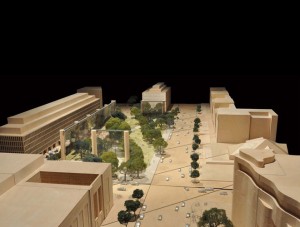 James Stirling once said, “Architects have always looked back in order to move forward.” That is precisely what Frank Gehry did in his original design proposal for the Eisenhower Memorial: in a city of classical temples he created a roofless temple, albeit magnified to suit the scale of the 4-acre site. It was obvious that he was looking back to the Lincoln Memorial (an alternative version, a circle of columns, channeled the Jefferson Memorial). Gehry hung a giant mesh tapestry from the columns, but their prime purpose was not to support the tapestry but to define a space. As my fellow commissioner on the Commission of Fine Arts, Michael McKinnell observed, a hundred years from now, whatever happened to the tapestry, the sense of a vast temple would remain. As the design evolved the number of columns was reduced from 13 to 10, and the row along Independence Avenue disappeared completely. Nevertheless, the sense of enclosure persisted. At a meeting of the Commission of Fine Arts three days ago, the memorial design was approved, but it was suggested that the two pairs of columns on the east and west sides be removed entirely. That would be a mistake, for instead of a roofless temple, what would be left would be a giant movie screen, supported on unaccountably large columns.
James Stirling once said, “Architects have always looked back in order to move forward.” That is precisely what Frank Gehry did in his original design proposal for the Eisenhower Memorial: in a city of classical temples he created a roofless temple, albeit magnified to suit the scale of the 4-acre site. It was obvious that he was looking back to the Lincoln Memorial (an alternative version, a circle of columns, channeled the Jefferson Memorial). Gehry hung a giant mesh tapestry from the columns, but their prime purpose was not to support the tapestry but to define a space. As my fellow commissioner on the Commission of Fine Arts, Michael McKinnell observed, a hundred years from now, whatever happened to the tapestry, the sense of a vast temple would remain. As the design evolved the number of columns was reduced from 13 to 10, and the row along Independence Avenue disappeared completely. Nevertheless, the sense of enclosure persisted. At a meeting of the Commission of Fine Arts three days ago, the memorial design was approved, but it was suggested that the two pairs of columns on the east and west sides be removed entirely. That would be a mistake, for instead of a roofless temple, what would be left would be a giant movie screen, supported on unaccountably large columns.
On Culture and Architecture
